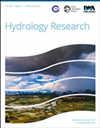魁北克南部季节性日最小流量的时空变化:气候、农业和湿地影响的综合
IF 2.4
4区 环境科学与生态学
Q2 Environmental Science
引用次数: 1
摘要
本研究比较了气候、农业和湿地对加拿大魁北克南部17个流域1930-2019年季节性日最小流量时空变化的影响。在空间变异上,相关分析表明,季节日最小流量与流域农业表面积在春、夏、秋主要呈负相关。在冬季,这些流量与湿地表面积和三月气温呈正相关,与降雪量呈负相关。在4个季节中,北岸(农业面积较小,湿地面积较大)的日最小流量值均高于南岸。在时间变率方面,6个试验的长期趋势分析表明,大部分农业流域由于农业面积减少,四季流量显著增加,有利于水分入渗,夏秋两季降雨量增加。另一方面,降雪量的减少导致在几个较少农业流域观测到的夏季日最小流量减少。本文章由计算机程序翻译,如有差异,请以英文原文为准。
Spatial–temporal variability of seasonal daily minimum flows in southern Quebec: synthesis on the impacts of climate, agriculture and wetlands
This study compares the impacts of climate, agriculture and wetlands on the spatio-temporal variability of seasonal daily minimum flows during the period 1930–2019 in 17 watersheds of southern Quebec (Canada). In terms of spatial variability, correlation analysis revealed that seasonal daily minimum flows were mainly negatively correlated with the agricultural surface area in watersheds in spring, summer and fall. In winter, these flows were positively correlated with the wetland surface area and March temperatures but negatively correlated with snowfall. During all four seasons, spatial variability was characterized by higher daily minimum flow values on the north shore (smaller agricultural surface area and larger wetland surface area) than those on the south shore. As for temporal variability, the application of six tests of the long-term trend analysis showed that most agricultural watersheds are characterized by a significant increase in flows during the four seasons due to the reduction in agricultural area, thus favoring water infiltration, and increased rainfall in summer and fall. On the other hand, the reduction in the snowfall resulted in a reduction in summer daily minimum flows observed in several less agricultural watersheds.
求助全文
通过发布文献求助,成功后即可免费获取论文全文。
去求助
来源期刊

Hydrology Research
Environmental Science-Water Science and Technology
CiteScore
5.30
自引率
7.40%
发文量
70
审稿时长
17 weeks
期刊介绍:
Hydrology Research provides international coverage on all aspects of hydrology in its widest sense, and welcomes the submission of papers from across the subject. While emphasis is placed on studies of the hydrological cycle, the Journal also covers the physics and chemistry of water. Hydrology Research is intended to be a link between basic hydrological research and the practical application of scientific results within the broad field of water management.
 求助内容:
求助内容: 应助结果提醒方式:
应助结果提醒方式:


